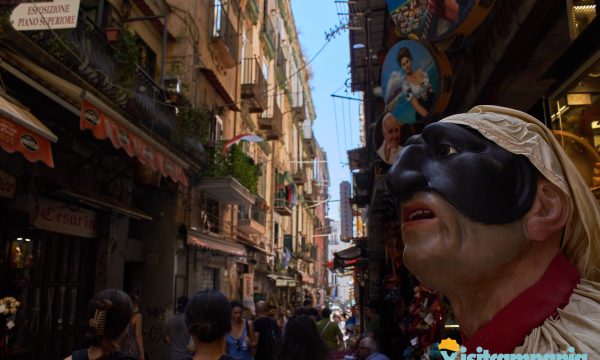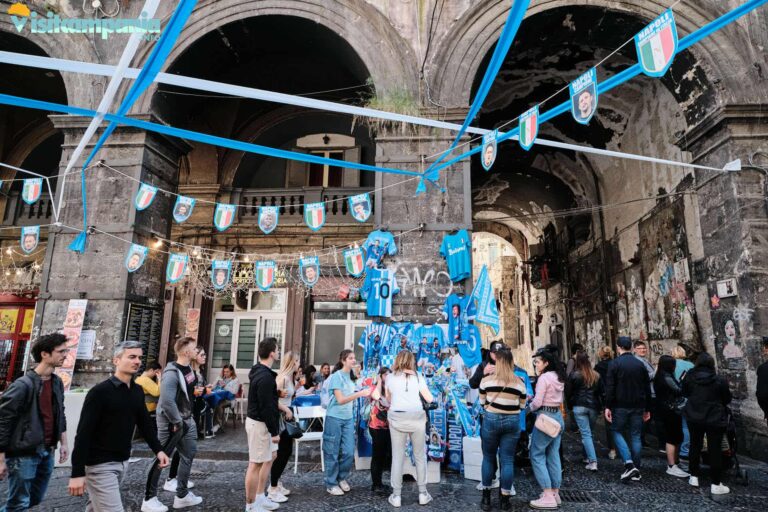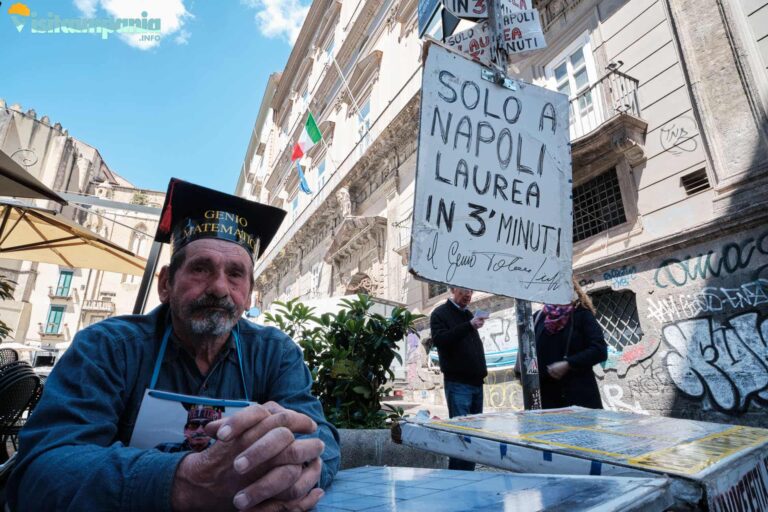What are decumani?

The decumani area, which includes the famous Spaccanapoli and Via San Gregorio Armeno, is the essential stop for those visiting Naples for the first time. The area that interests us here falls within a larger UNESCO heritage area and is between Via San Sebastiano to the west and Via Duomo to the east. However, the decumani extend beyond the latter in the Forcella district. It has a perimeter of about 2 km, follows the ancient road route of Greek origin and is the heart of the vast historic center of the city, the largest in Italy with its 17 km2 of surface.
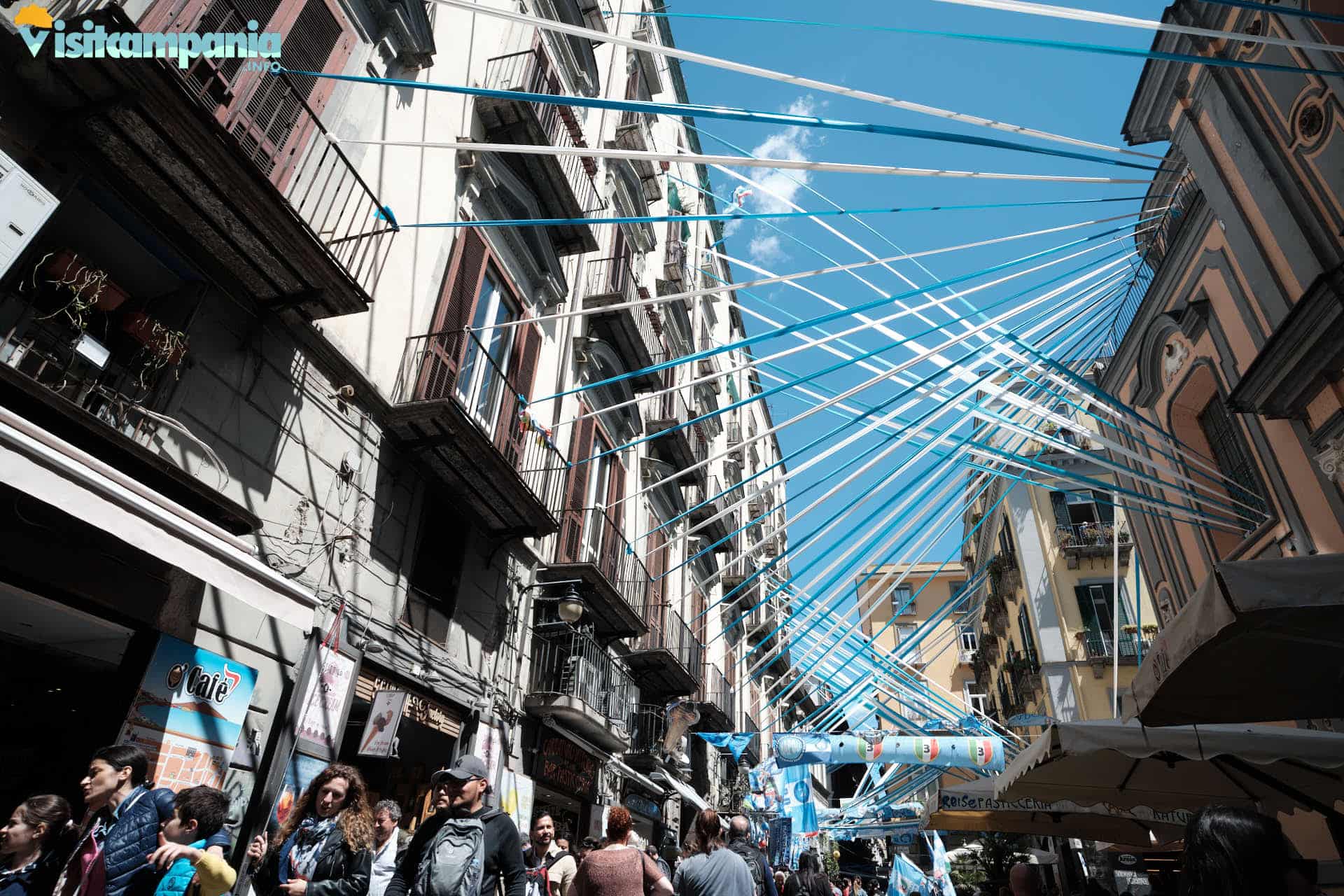
As mentioned, the origin of the area is ancient and dates back to the sixth century BC when the Greek colonists of Cuma founded Neapolis as opposed to Partenope which was developing on the current hill of Pizzofalcone.
The new city immediately presented a road structure with orthogonal axes. It consisted of three main roads, called plateiai, which developed from east to west parallel to the coast. These were then cut perpendicularly by smaller streets called stenopoi drawing regular quadrangular blocks. With the Romanization of the city the original terms were replaced. The plateiai became decumani and the stenopoi became hinges but the structure remained, and still remains today, the same.
A journey through time at your fingertips
Thus, after millennia, it is still possible to walk the lower decumanus, today commonly called Spaccanapoli even if there is no road with this name. For the stretch that interests us here, it embraces via Benedetto Croce and via San Biagio dei Librai. Among the three decumani it is the one that has the greatest correspondence with the original Greek route. It has been lengthened, over the centuries, to creep into the Spanish quarters of seventeenth-century origin. To visually grasp the meaning of the name Spaccanapoli, I suggest you go to the walls of Castel Sant’Elmo from which you can see all the development of this road axis and how you actually split the city into two parts.

The major decumanus, the central one, is now identified as Via dei Tribunali. From the beginning it was the main road on which the Greek agora opened, then Roman forum. Traces of these ancient structures have been found near Piazza San Gaetano and are accessible by visiting Neapolis Underground in the Monumental Complex of San Lorenzo Maggiore.
The upper decumanus, finally, is now identified by via Sapienza, via Pisanelli and strada dell’Anticaglia, always with reference to the stretch that interests us here, and, among the three decumani, it is the one that has undergone the greatest upheavals compared to the original route.
If the road layout has remained substantially unchanged, the buildings, churches and archaeological finds testify, instead, the millennial evolution and the constant transformation of the city. Precisely this historical-artistic stratification, still clearly visible today, is the basis of the recognition of the historic center of Naples, and of the decumani area in particular, as a UNESCO World Heritage Site in 1995.
A day at the decumani: let’s discover the genius loci of Naples
After this necessary premise it is now time for some advice that, I hope, will allow you to enjoy the visit to the decumani of Naples. What I suggest, especially if you are on your first visit to the city, is a slow walk in the center with fleeting peeks at the main places of interest with free access. Only then, based on your interests and the time you have available, you can dedicate more in-depth visits to specific sites.

For this reason, in the map I divided the places of interest into free and paid. Not because one is more interesting than the other but because paid ones usually require more time. Wandering around, let yourself be tempted by the endless culinary offer you will come across. Wallet pizzas, fried polenta flakes, babbà and sfogliatelle are just a few examples of that authentic street food that has been at home here since long before famous chefs and savvy marketing strategies created street food so fashionable today. Finally pay attention to the many folkloric characters that crowd the streets of Naples. Without them the city would lose much of its irresistible charm.

Let’s go back to the initial map. In red and yellow are highlighted the areas protected by UNESCO, over 10 km2 of surface, although with different protocols and constraints. The blue rectangle delimits, instead, the area of the decumani including, as mentioned, between the hinges via San Sebastiano to the west and via Duomo to the east.
And now, on the march. Let’s go into the decumani with one last warning. The places that I point out below are just some of those where you will come across. Therefore, take the list that I propose only as a rough suggestion and nothing more. Let your curiosity guide you.
The main attractions
-
Church of Gesù Nuovo
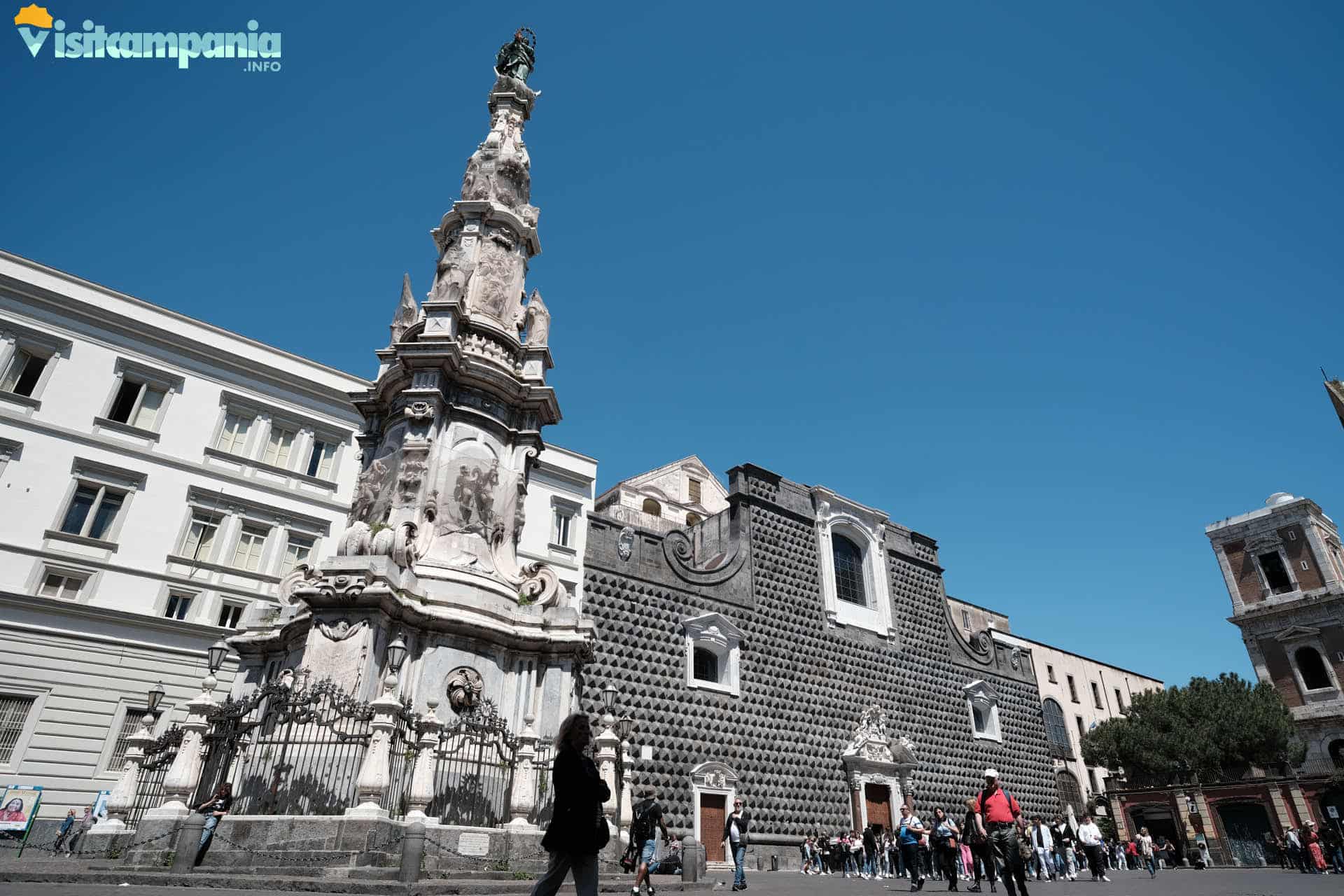
The Church of Gesù Nuovo is a Baroque basilica located in Piazza del Gesù Nuovo, in front of the obelisk of the Immaculate Conception. It stands where previously stood Palazzo Sanseverino of which remains the splendid diamond punch on the main façade. The palace was expropriated by Viceroy Don Pedro of Toledo once the revolt against the introduction of the Inquisition in the city supported by Ferrante Sanseverino was quelled. Later purchased by the Jesuits, it was converted into a church.
It is one of the most important and largest churches in the city, characterized by a remarkable artistic heritage baroque, the result of the work of some of the most influential artists of the Neapolitan school including Cosimo Fanzago, Massimo Stanzione, Domenico Antonio Vaccaro and Francesco Solimena that we find in other churches in the city. Inside is also preserved the body of Saint Joseph Moscati, a Neapolitan doctor canonized by Pope John Paul II in 1987. In 2007RAI produced a very touching miniseries, Giuseppe Moscati – L’amore che guarisce, with Giuseppe Fiorello in the role of the Neapolitan doctor. Entrance to the church is free.
-
Monumental Complex of Santa Chiara

The Monumental Complex of Santa Chiara is an ancient Franciscan complex located in the historic center of Naples, in the heart of the decumani area. Built in the fourteenth century, it includes a Gothic-style church and a cloister with crossed avenues with majolica pillars and seventeenth-century frescoes. Inside the complex there is also a museum that houses treasures that survived the bombing that almost destroyed it during the Second World War, remains of an ancient Roman spa and a traditional nativity scene. Entrance to the basilica is free while access to the rest of the monumental complex is subject to charges.
-
Venice Palace

Palazzo Venezia is a historic building located along Spaccanapoli, in the heart of the decumani area. It derives its name from the fact that it was the seat of the Venetian Embassy in the Kingdom of Naples. Although the fresco decorations of the interiors have largely been lost, what makes the palace truly extraordinary is the hanging garden with the Pompeian house in neoclassical style and the cave of the Madonnina, a small chapel dedicated to the Madonna placed under a frescoed vault. The historic apartments and the garden, freely accessible, are managed by the cultural association PA. VE. In addition, the association runs a small bar offering the opportunity to relax in a truly surprising place, perhaps taking advantage of the many events that the association itself organizes.
Palazzo Venezia (video)
-
San Gregorio Armeno Street

Among the hinges that intersect the decumani, the most famous is Via San Gregorio Armeno, known for its artisan shops of cribs literally stormed by tourists during the Christmas holidays so as to make the pedestrian one-way street. The tradition of the cribs of San Gregorio Armeno has ancient origins: in Roman times, along this road there was a temple dedicated to Ceres and the inhabitants used to offer small terracotta statues as an ex voto. However, the birth of the Neapolitan crib itself is more recent and dates back to the late eighteenth century.
In addition to the craft shops, Via San Gregorio Armeno immediately strikes for the large arched bell tower overlooking the street and which serves as a pedestrian connection between the monastery and the church of San Gregorio Armeno. Other places of interest, in addition to the church of San Gregorio and its cloister, are the church of San Gennaro all’Olmo, a building identified by a plaque that tradition wants to have been the house of San Gennaro and the basilica of San Lorenzo Maggiore.
-
Dolls Hospital
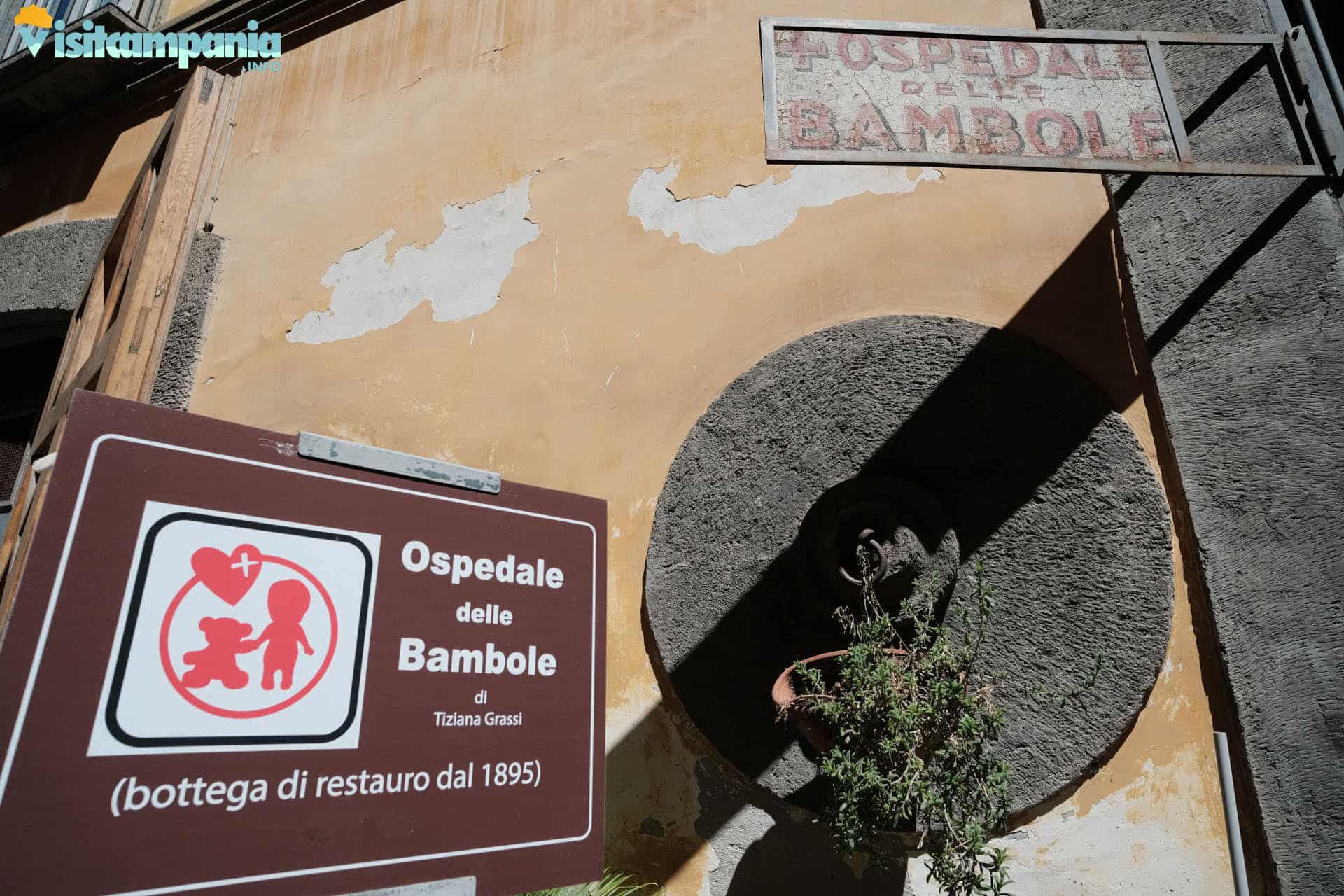
Inside the courtyard of Palazzo Marigliano, in via San Biagio dei Librai (Spaccanapoli), there is the Dolls Hospital. The Hospital is a museum that collects dolls and vintage toys and a laboratory specialized in restoration, one of the most important in Italy.
The origin of the workshop dates back to 1895 when Luigi Grassi opened a small workshop for the construction of sets and the repair of theatrical equipment, cult objects, stage puppets and puppets. Little by little, almost by chance, the inhabitants of the area also began to turn to him to have their children’s toys repaired, in an era still far from disposable consumerism. Soon the laboratory begins to crowd with broken dolls and spare parts to the point of resembling a real hospital, the Doll Hospital, in fact.
From generation to generation the family business arrives in the hands of Tiziana Grassi, the current “primary” of the Hospital, who in 2017 decided to open a real museum open to the public. The museum is organized in wards and wards like a real hospital enriched with multimedia supports. A unique experience for young and old and an opportunity to rediscover our past through the games that accompanied us in childhood.
-
San Gennaro by Jorit Agoch

At the intersection of Via Forcella and Via Duomo , at the eastern limit of the decumani area that interests us here, drawn on the façade of a building, you can see the mural of San Gennaro by Jorit Agoch. Jorit, pseudonym of Ciro Cerullo, is an Italian street art artist. He has gained international recognition from major newspapers thanks to his ability to combine realism, technical skill and social messages. His works are characterized by two red stripes on the cheeks of the faces, a symbol of African rituals. He exhibits in international museums and art galleries, but his artistic expression remains linked to the street and free use. He has made murals all over the world, from China to South America, and many are right here in Naples.
If you like this type of street art, do not miss the opportunity to go and see the murals with a strong symbolic impact that the artist has created in Barra, Scampia, Ponticelli, San Giovanni a Teduccio and in other neighborhoods, often difficult, of the city supporting the desire for redemption.
Street Art in Naples: Jorit’s works not to be missed (website)
-
Cathedral of Santa Maria Assunta (Duomo) and museum of the Treasure of San Gennaro
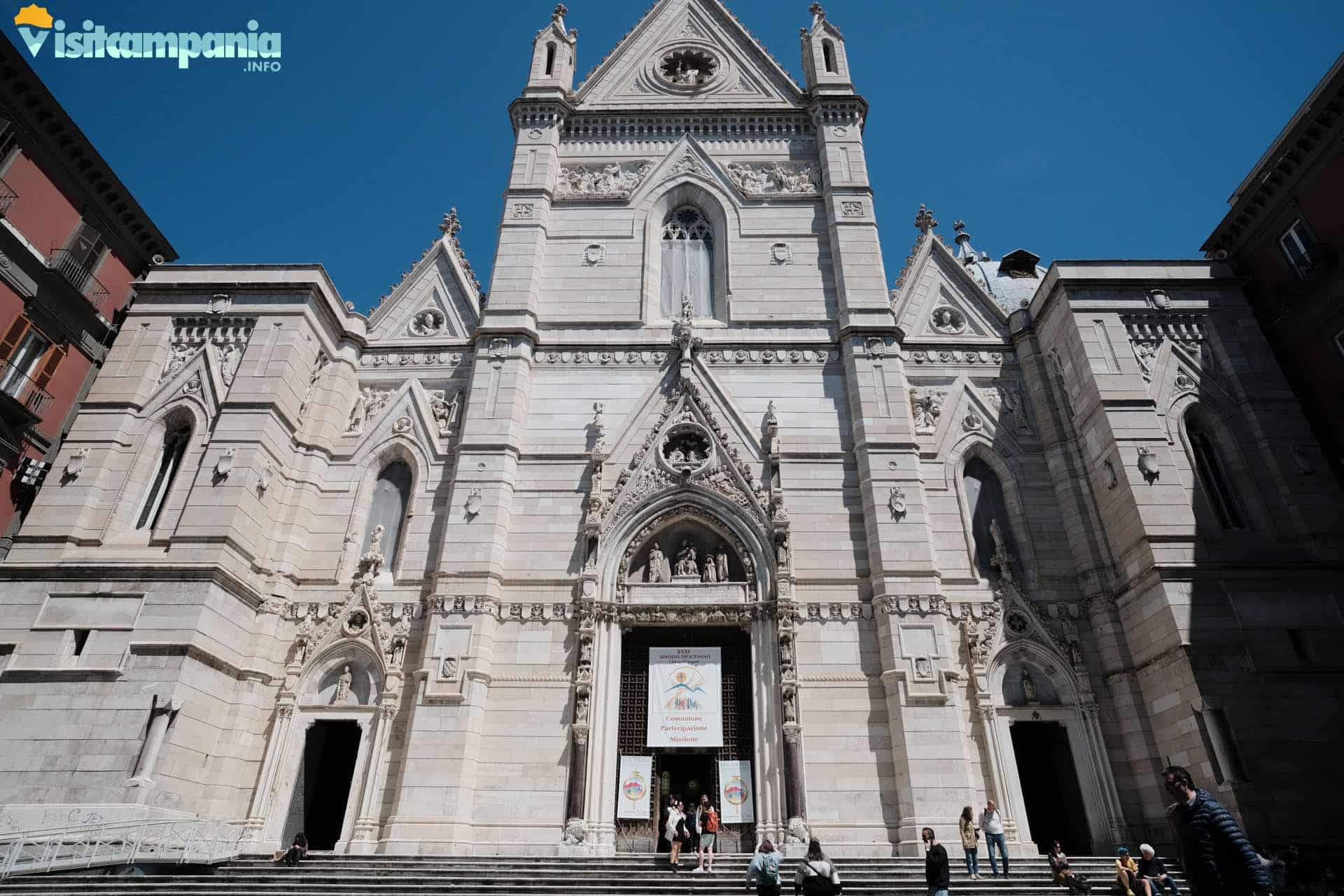
The Cathedral of Naples, officially the Cathedral of Santa Maria Assunta, is the main church of the city. It presents an overlap of architectural styles ranging from fourteenth-century Gothic to Baroque and Neo-Gothic of the eighteenth century. From the cathedral there is also access to two other churches built independently and which today have side chapels. From the left aisle, in fact, you enter the Basilica of Santa Restituta which houses the baptistery of San Giovanni in Fonte, the oldest in the West. On the opposite side, however, is the Royal Chapel of the Treasure of San Gennaro which preserves the relics of the patron saint of the city and from which you can access the Museum of the Treasure of San Gennaro.
The museum area, of over seven hundred square meters, exhibits precious works such as jewelry, statues, busts, fabrics and paintings. These include the Mithras and the necklace of San Gennaro. In addition, the museum itinerary allows a visit to the three sacristies of the Chapel of the Treasure, which house paintings by renowned artists such as Luca Giordano, Massimo Stanzione, Giacomo Farelli and Aniello Falcone, recently restored.
In addition to an artistic point of view, the Cathedral is an important place of worship in which takes place, three times a year (the Saturday before the first Sunday of May, September 19 and December 16), the rite of the dissolution of the blood of San Gennaro.
Access to the basilica and the side chapels is free while access to the Treasury museum is subject to charges.
-
Banksy Graffiti
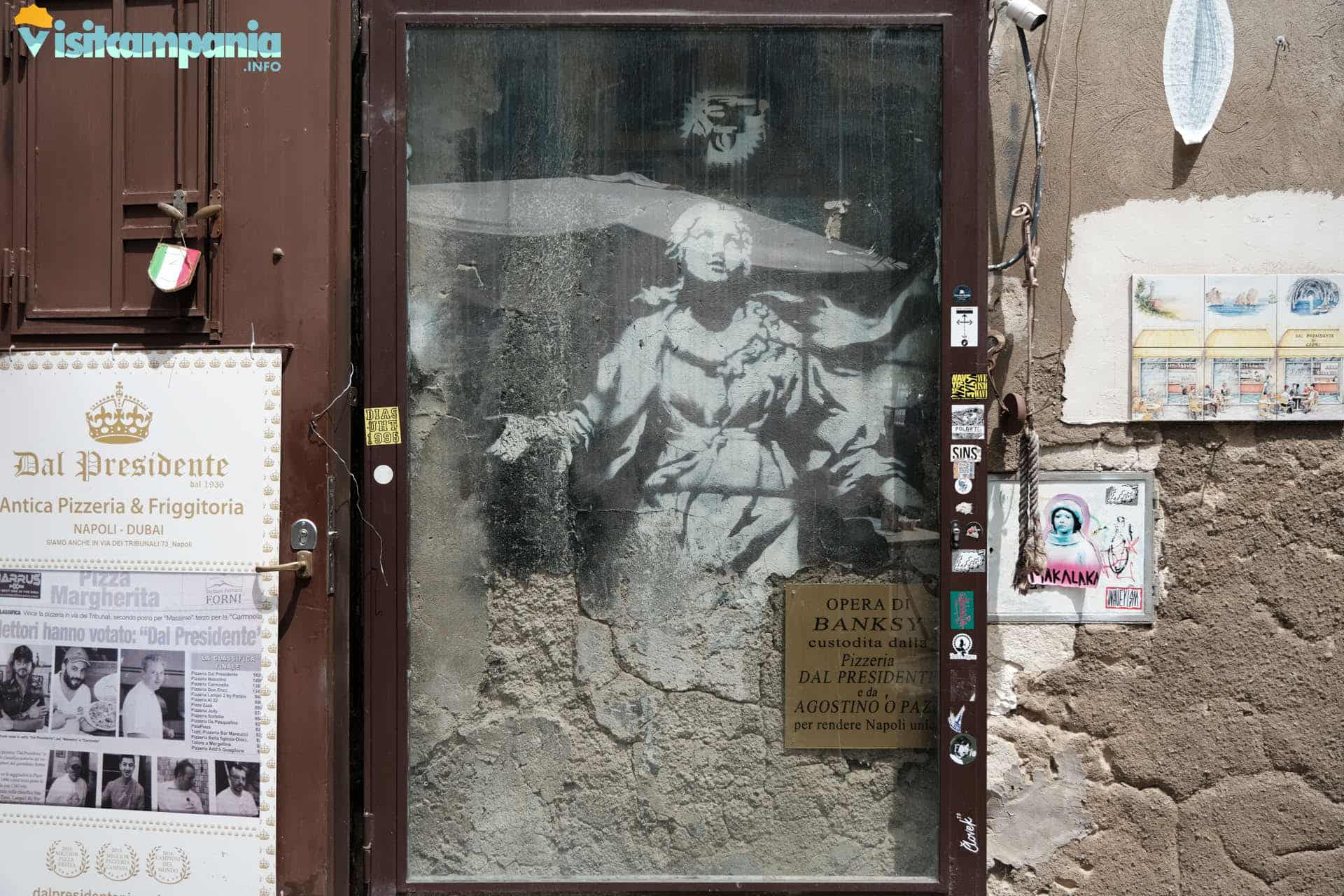
On the battered wall of a building in Piazza Girolamini, on Via dei Tribunali not far from Via Duomo, you can see the Madonna with the gun attributed to Bansky, a highly quoted British street art artist whose identity is, to date, unknown. The graffiti represents a Madonna with a gun instead of a halo and is one of only two works by the artist visible in Italy today. In addition to this, in fact, in 2019 Bansky made the child of Venice. A third work was also made in Naples near the monastery of Santa Chiara but has been lost. To prevent this from having the same end, some private individuals have protected the Madonna with the gun with a glass frame waiting for public institutions to do their part.
-
Monumental complex of the Girolamini

The monumental complex of the Girolamini is a building built between the late sixteenth and mid-seventeenth centuries, taking its name from the religious followers of St. Philip Neri. The complex, enriched in the eighteenth century, became a National Monument in 1866. The Girolamini include a monumental church, a picture gallery and a famous library. The picture gallery houses sixteenth- and seventeenth-century paintings by masters such as Andrea Sabatini, Agostino Tesauro, Battistello Caracciolo, Jusepe De Ribera and Andrea Vaccaro.
Currently (May 2023), the Library and the monumental complex of the Girolamini are closed to the public due to a profound restoration work in progress. However, some library services are still active and accessible upon reservation.
-
Basilica of San Lorenzo Maggiore – The Underground Neapolis – Monumental Complex of San Lorenzo Maggiore
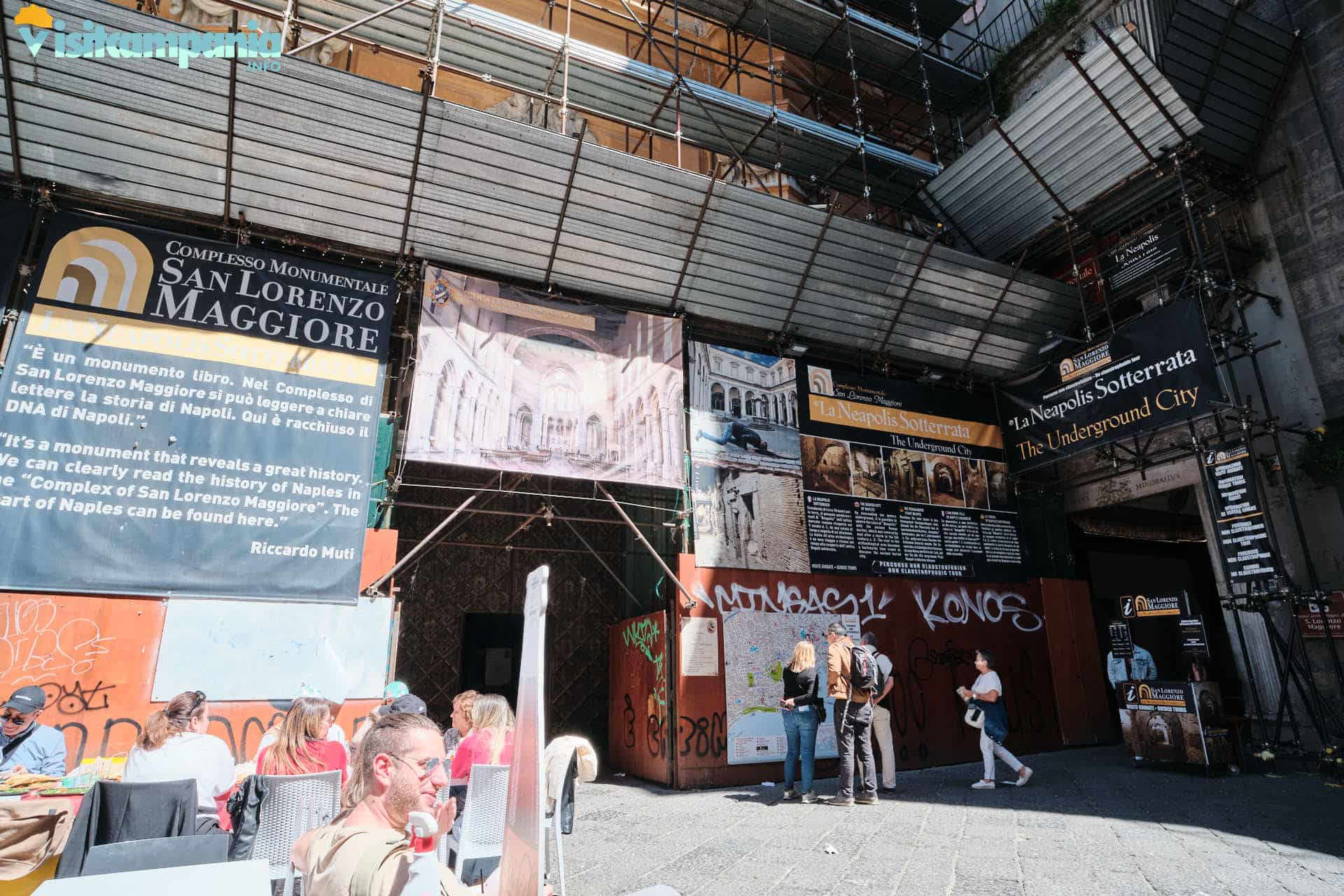
In Piazza San Gaetano, the center of gravity of the decumani area, stands the Basilica of San Lorenzo. In the Gothic style French, it was the first church to follow this style in Italy after the introduction by the architects following Charles I of Anjou. During the eighteenth century were added inserts and baroque decorations only partially survived subsequent restoration work. The current plan of the basilica, conceived according to the Franciscan ideals, includes a large central nave, an apse and 23 side chapels that give the complex a majestic appearance. The basilica, with free access, is part of the larger complex La Neapolis Sotterrata – Complesso Monumentale San Lorenzo Maggiore which includes the underground archaeological area of the ancient Roman forum, the Chapter House, the Sixtus V room, and the museum. The entrance to the complex is subject to charges.
-
Basilica of San Paolo Maggiore

The majestic Basilica of San Paolo Maggiore is located in Piazza San Gaetano, at the intersection of Via dei Tribunali and Via San Gregorio Armeno. The basilica was built on the ruins of the temple of the Dioscuri, dating back to the first century AD and whose front with tympanum resisted until 1688 when it was definitively destroyed by an earthquake. Traces of the temple are still visible in two Corinthian columns with lintels forming part of the main façade of the church. The interior, in Baroque style, preserves works by Massimo Stanzione, Domenico Antonio Vaccaro and Francesco Solimena among others, all artists who have also left their mark in other buildings and churches in the city including the Certosa di San Martino and the Church of Gesù Nuovo.
-
Naples Underground and Roman Theatre of Neapolis

In Piazza San Gaetano, in an alley that stretches on the left side of the Basilica of San Paolo Maggiore, is the entrance to Napoli Sotterranea. I tell you right away that it is not the only one you will meet. In fact, another “underground Naples” is already located in the same square and can be accessed from the Complex of San Lorenzo Maggiore. Also in the area of the decumani is also the Lapis Museum – Water Museum. Then there is the Naples Underground in Vico S. Anna di Palazzo, near Via Toledo, not to forget, finally, the Bourbon Gallery. In short, Naples offers various underground routes all very different and all very interesting.
What I’m talking about here proposes an articulated path. It includes a visit to the remains of a Greek-Roman theater which can be accessed, surprisingly, from the floor of a house. The visit also includes a path in ancient underground cisterns dug into the tuff and then used as a refuge during the Second World War in which a small experimental vegetable garden and a room formerly used as a cellar were also set up. All at a depth of 35 meters. The route does not present difficulties and is also suitable for children. Obviously I strongly advise against it if you suffer from claustrophobia or have walking problems but otherwise be prepared to remain open-mouthed.
-
The nativity scene of the people
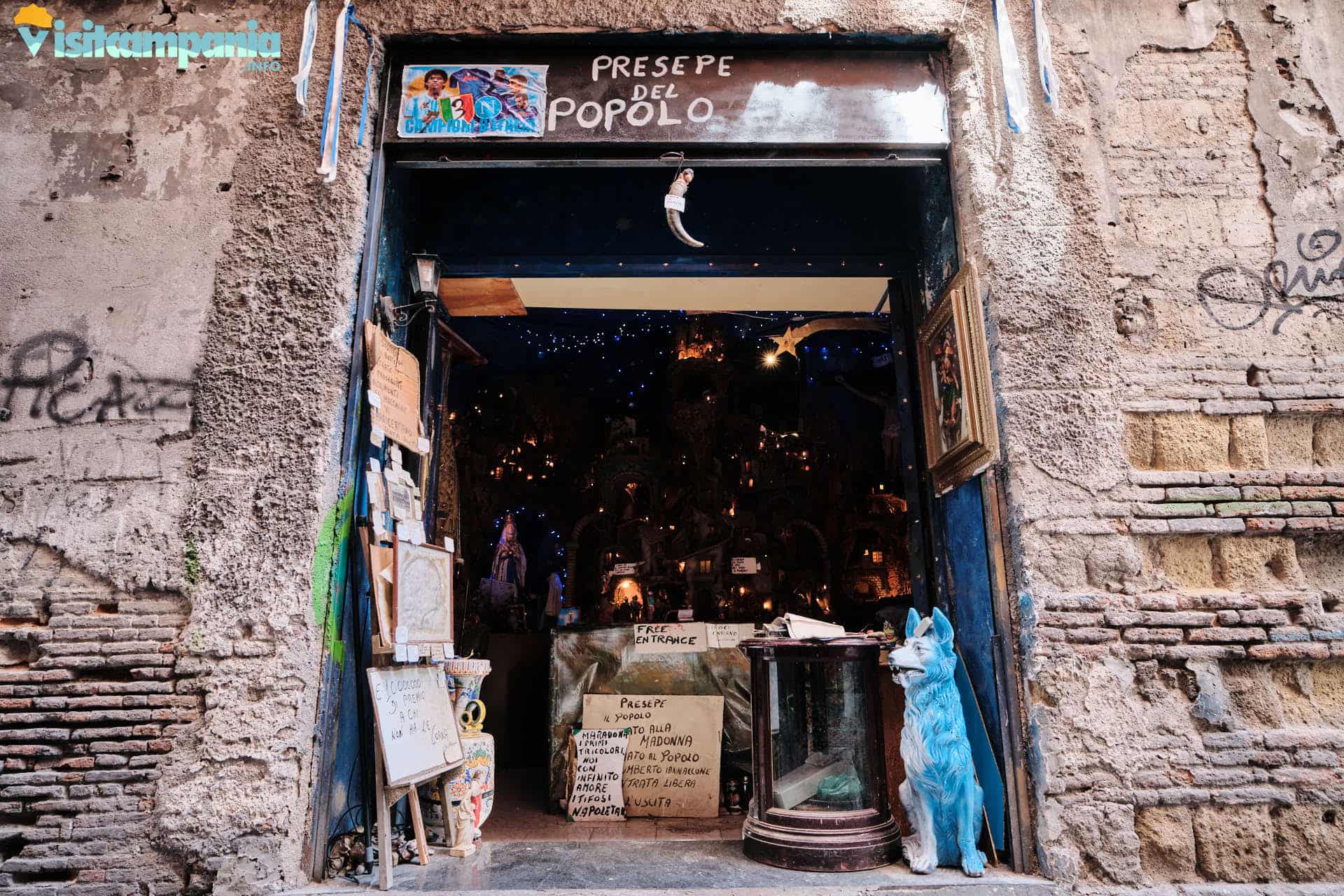
In Strada dell’Anticaglia (upper decumanus) not far from the Roman Theater, in a room on the ground floor where once there was a shoemaker’s shop, you can see today the Nativity of the People. The crib is due to the skilled hands and passion of Don Umberto Iannaccone. Retired in 1993, he decided to put his knowledge at the service of the people of whom he defined himself as a craftsman.
The crib has a circular structure and, to see it well, it is necessary to enter and turn around. Precisely for this reason, one of the many signs posted here and there on the door informs you that the entrance is free as well as the exit. If you want to leave an offering, another sign informs you that it will be donated to the poor who do not ask. Here, then, that visiting this place you will not find yourself in front of a monumental crib like the one you can see at the Certosa di San Martino or the Royal Palace of Caserta. Instead, you will find yourself in an intimate place, overflowing with love.
The nativity scene in via dell’Anticaglia (website)
-
The world’s smallest museum of typography

On the upper decumanus, right in front of the premises that house the People’s Crib, well marked by a large sign, is the smallest museum in the world of typography. A magical place designed and built by Carmine Cervone. A typographer, he has put together objects and historical tools of typography, such as an authentic linotype of the late nineteenth century, with which he works every day. As he himself says, the idea is to create “a printing workshop that still operates, produces and works becoming a museum“. The museum, therefore, is not only made up of objects, such as a Typographic press of 1840 or various friezes for the gilding of hot books, but from the art of Carmine himself that offers us the unmissable opportunity to see them in operation. “I propose a new thing“, says Carmine, “What you’ve never seen“.
-
Museum Complex Santa Maria delle Anime del Purgatorio in Arco
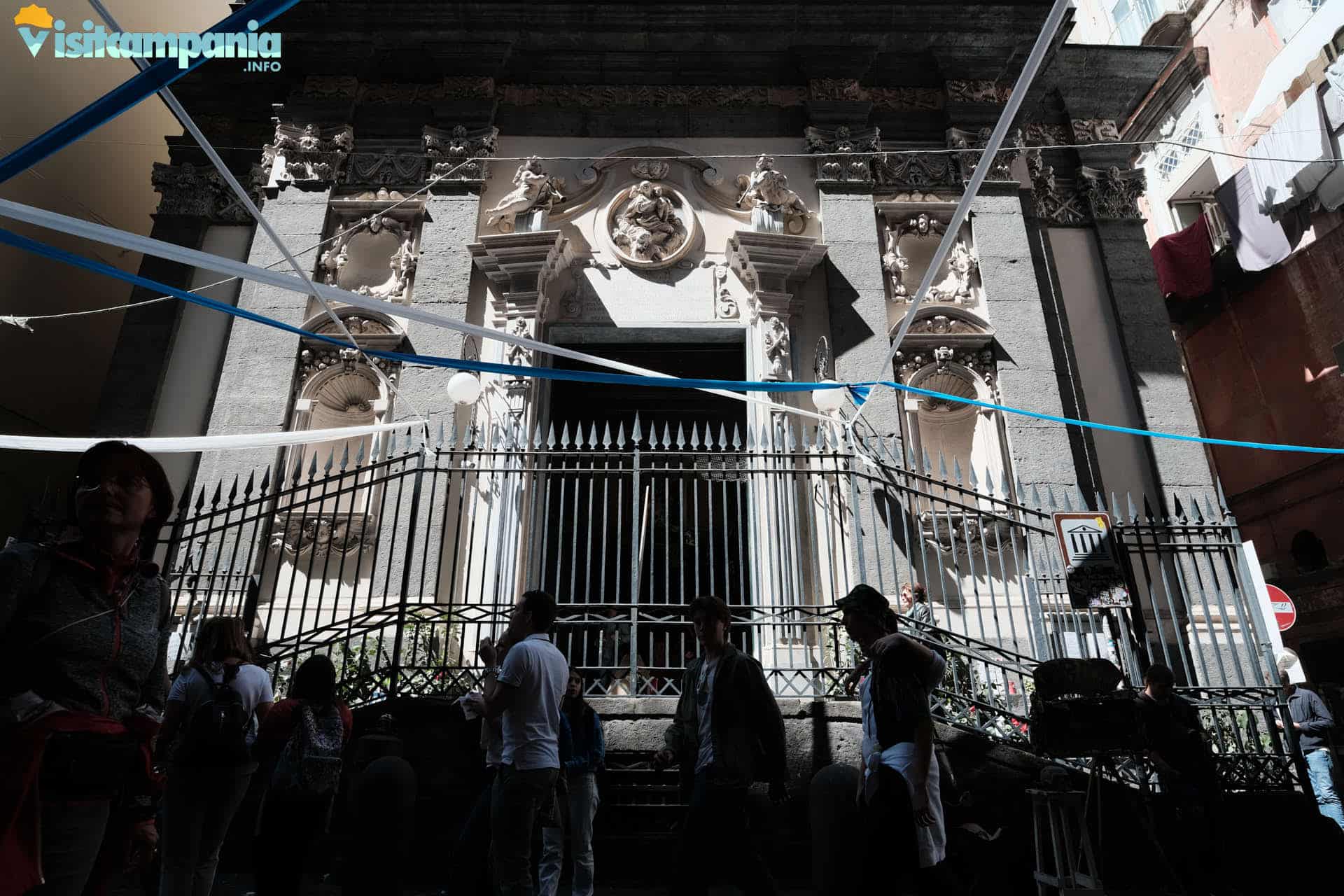
In the historic center, on Via dei Tribunali (major decumanus), stands the Museum Complex Santa Maria delle Anime del Purgatorio in Arco. The structure, baroque, is conceived on two levels: an upper church representing the earthly dimension and a lower church, hypogeum, which served as a cemetery for poor souls, pezzentelle, and symbolizes Purgatory. Thus, the entire complex is decorated with works by artists such as Massimo Stanzione, Luca Giordano and Andrea Vaccaro, who remind visitors of the importance of prayers to free souls from Purgatory.
Among all, a special place belongs to Lucia, whose skull crowned with a bridal veil and a chaplet is exposed in a votive niche in the hypogeum. According to legend, based on a fact that really happened in the eighteenth century, Lucia was a 17-year-old girl, daughter of a Neapolitan nobleman, who died of tuberculosis shortly after marriage. She is considered the protector of young brides and is invoked as a mediator for prayers and invocations. In addition to the churches, the complex includes the Museum of the Opera, located in the sacristy and in the Oratory of the Immaculate Conception annexed to the Church of Purgatory in Arco. The visit to the upper church is free. The visit to the Hypogeum and the Opera Museum is, however, subject to a fee.
-
Bust of Pulcinella
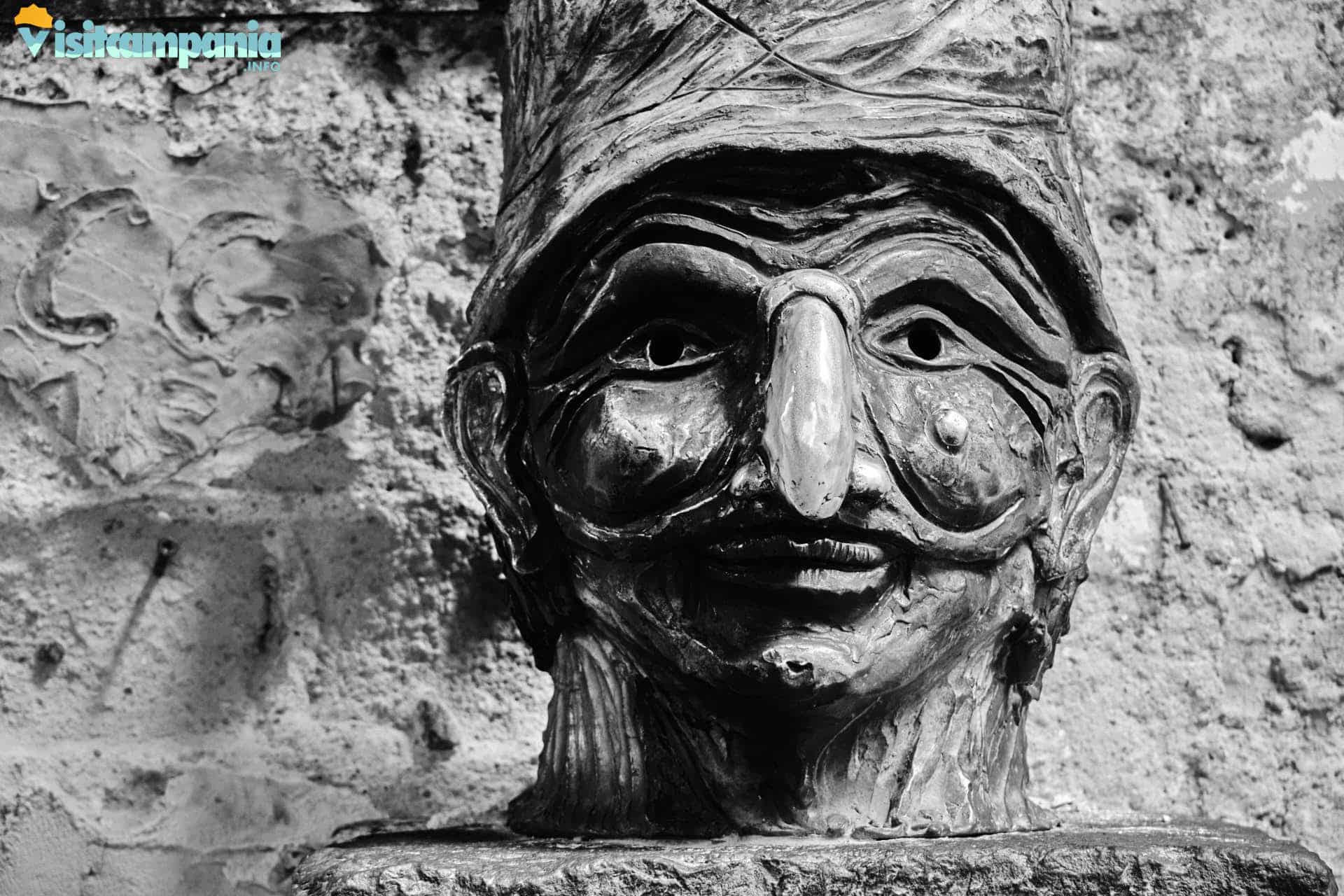
In the middle of the decumani, on Via dei Tribunali on the corner with vico Fico al Purgatorio, there is a bronze bust of Pulcinella. Pulcinella is the Neapolitan mask of the commedia dell’arte, invented by Silvio Fiorillo in Acerra in the ‘600. It represents the typical Neapolitan, a character who laughs at his problems and makes fun of the powerful.
Legend has it that touching the nose of the sculpture brings good luck. The work is a gift to the city of the artist Lello Esposito. Internationally renowned, he also created the Pulcinella located in the Salvador Rosa metro station.
Pulcinella in the vico del fico al Purgatorio (video)
-
Lapis Museum
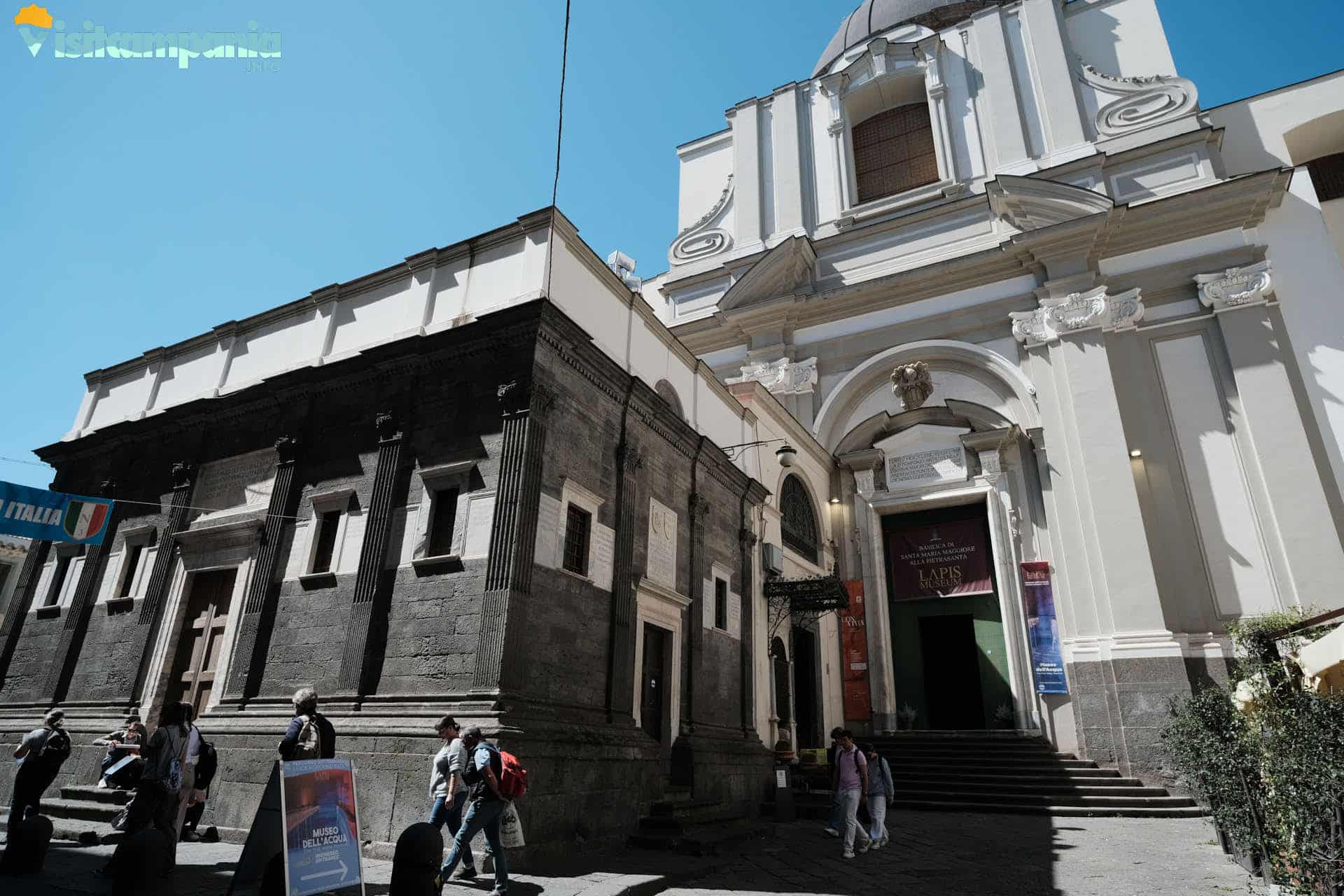
The Pietrasanta Complex, known today as LAPIS Museum, is amuseum complex located in the Basilica of Santa Maria Maggiore alla Pietrasanta, along Via dei Tribunali in Naples. The basilica was the first church in the city to be dedicated to the Virgin. It has an ancient history that reflects the history of the city itself. Built in 533 by Bishop Pomponio on the ruins of the temple of Diana and a Roman domus, the basilica was one of the four major basilicas of late antiquity. In 1600, due to damage caused by earthquakes, it was demolished and then completely rebuilt in 1656 in Baroque style by Cosimo Fanzago.
The visit route includes the basilica with the chapels, the crypt with the archaeological area that presents the remains of the ancient temple of Diana and the subsoil, Water Museum, which includes tunnels and cisterns of the Greek-Roman aqueduct. As for the other underground routes that Naples offers, the visit is not recommended for those suffering from claustrophobia while to facilitate access for those with walking problems there is the spectacular “archaeological elevator“. The LAPIS Museum also hosts temporary exhibitions that enrich the cultural offer and make it a tourist destination of great importance.
-
San Severo Chapel and the Veiled Christ
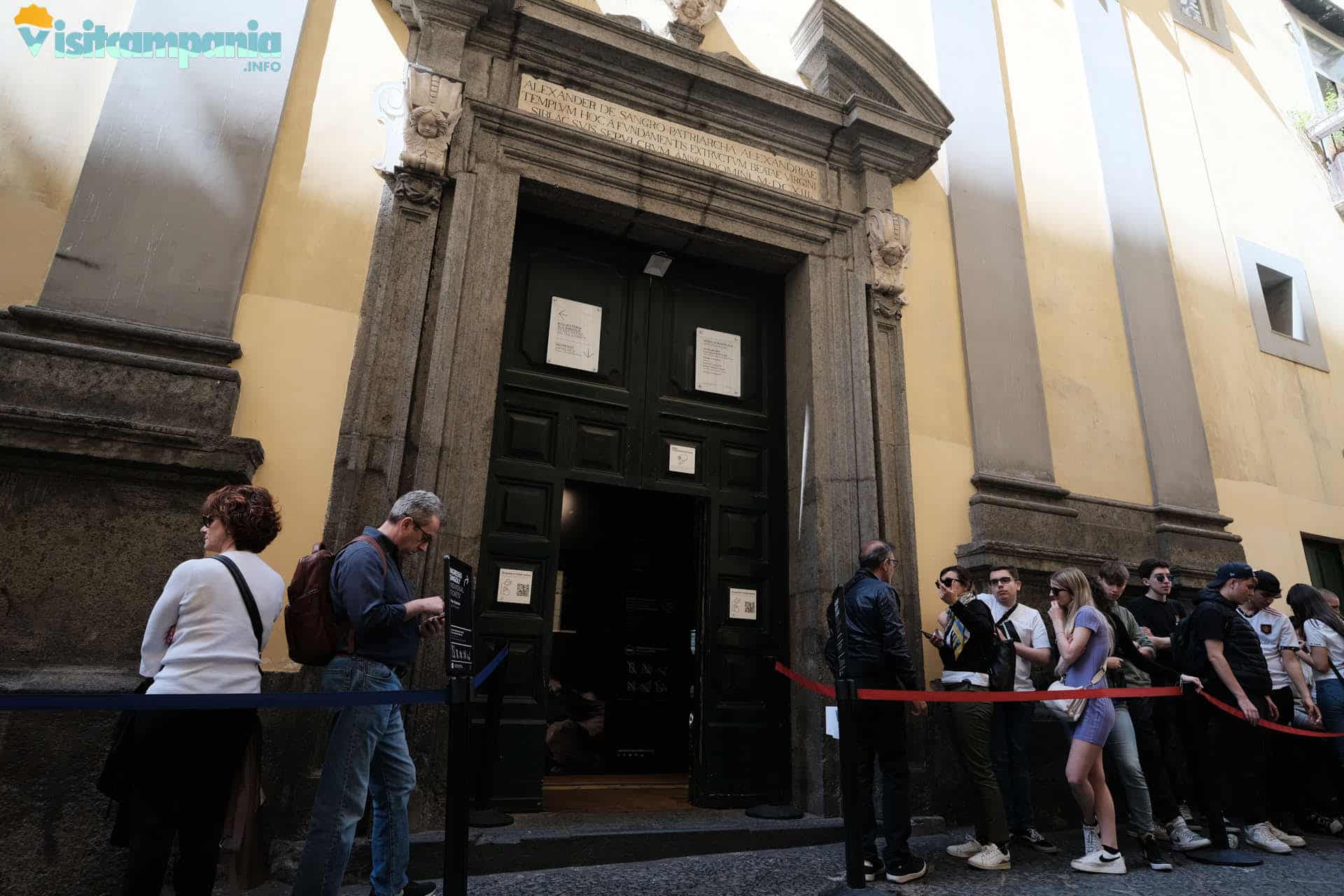
In via Francesco de Sanctis, between via dei Tribunali and piazzetta Nilo (Spaccanapoli), not far from piazza San Domenico Maggiore, is the small Sansevero chapel. The simple exterior appearance does not portend the baroque opulence of the interiors and the exceptional artistic value of the various sculptural works. Only the persistent long queue of tourists waiting to enter attracts attention and tickles curiosity. Once inside, however, you are rewarded for the wait. The evocative sculptural cycle of the Virtues, the surprising and mysterious Anatomical machines, faithful reproductions of the human body and the circulatory system whose realization is still shrouded in mystery, and, above all, the exciting Veiled Christ, a marble sculpture depicting Christ lying down and covered by a shroud, make the Sansevero chapel an authentic treasure chest of wonders. If Antonio Canova would have given ten years of his life to be able to boast the paternity of Christ, there will also be a reason. To find out, just enter.
-
Church of San Domenico Maggiore
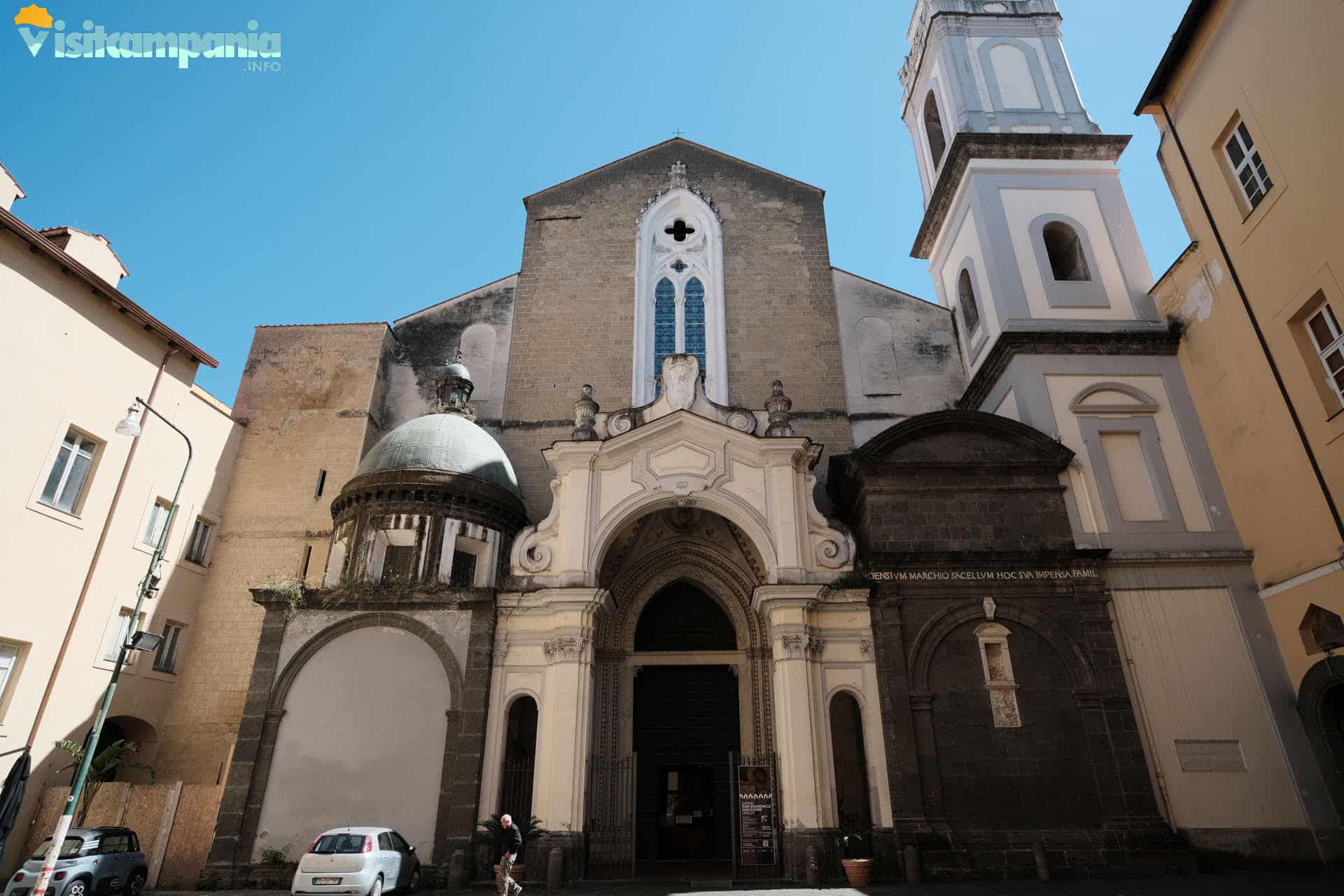
The Basilica of San Domenico Maggiore is located in the homonymous square along Via Benedetto Croce (Spaccanapoli), in the heart of the decumani. The main entrance to the Basilica and the convent is, however, located in vico San Domenico Maggiore. Built between 1283 and 1324 on the orders of Charles II of Anjou, it became the main place of worship of the Dominicans in the Kingdom of Naples and the church of the Aragonese nobility. This religious complex, together with the adjacent convent, represents an important example of Gothic-Angevin architecture. Access to the basilica is free. Access to the rest of the complex (chapter room and refectories, former library, sacristy, treasure room, cell of St. Thomas Aquinas and crypt of the Carafa di Roccella) is subject to charges.
-
Greek walls
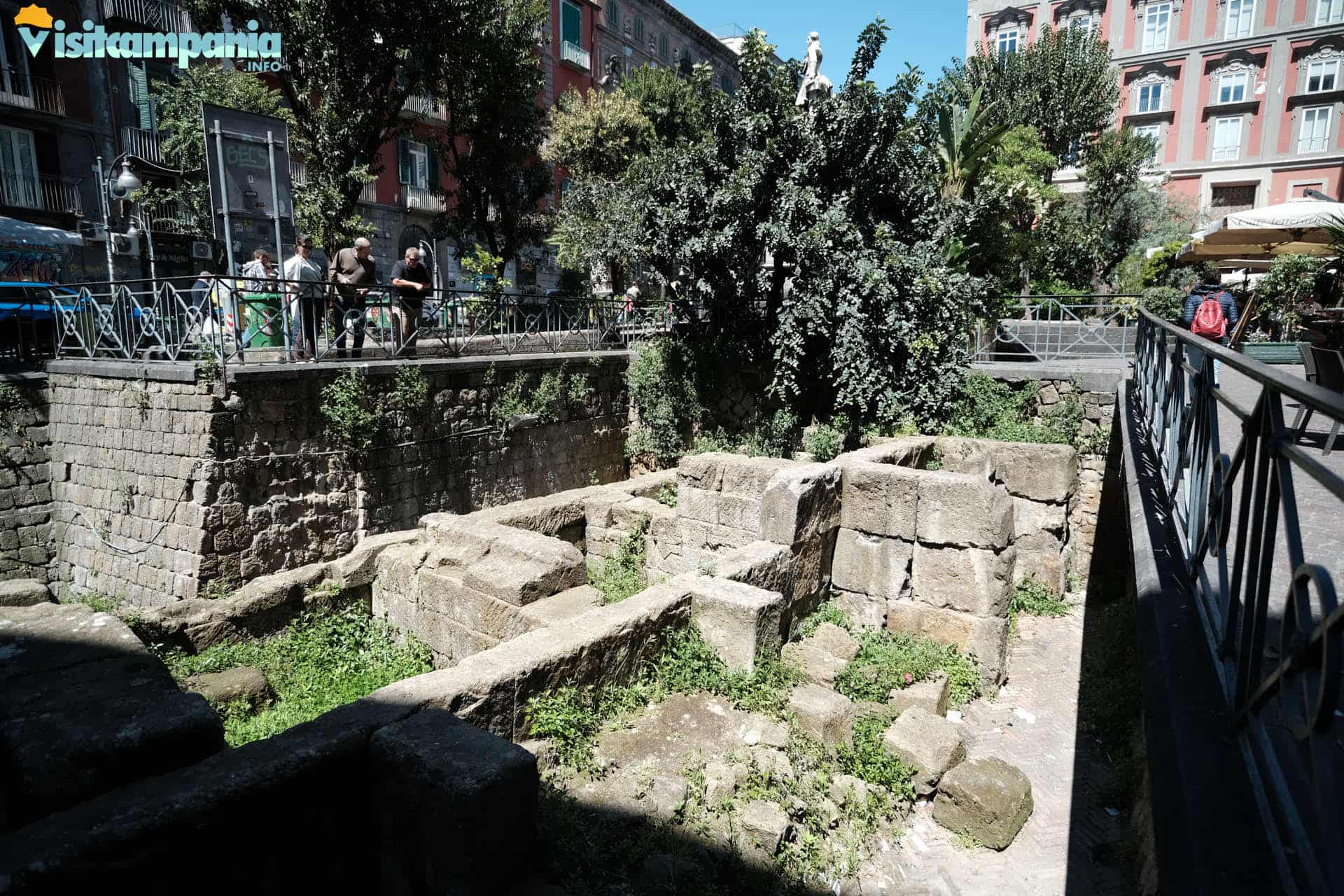
In Piazza Bellini , on the western edge of the decumani area, you can see a small stretch of the original Greek walls. Dating back to the V, IV century a. C., were accidentally unearthed in 1954. A further section discovered in 1984 always in Piazza Bellini has been re-buried. The discovery has made it possible to reconstruct the orographic situation of the time. The walking level was about 10 meters lower than the current one and this stretch of wall followed the edge of a hill now completely leveled.
The walls extended along the edges of the plateau on which ancient Naples stood, protected by natural valleys that served as defensive ditches. In addition, at the two extremes of the decumani, there were the access doors.
To allow the expansion of the city, over the centuries many of these walls have been demolished or enlarged by the various dominations that have succeeded (Romans, Normans, Angevins, etc.). Despite this, there are still many remains and testimonies of the original Greek fortifications.
Other remains of the ancient Greek walls can be found in the Forcella district, in Piazza Cavour and in Piazza Calenda.

